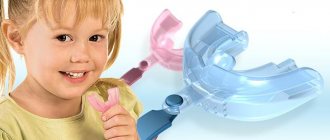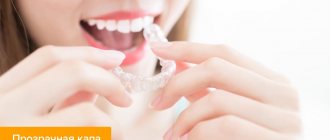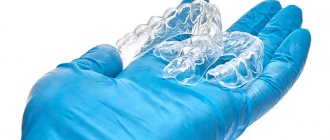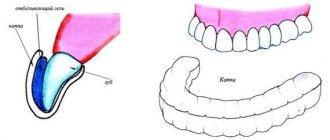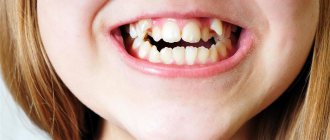The use of mouth guards takes place to solve various medical problems, and sometimes is a point of related application in various fields of activity.
A mouth guard is a structure (usually made of plastic) that is placed over teeth for therapeutic or protective purposes.
The word “kapa” is derived from the German “kappe” (“lid”, “cap”). You can find the spelling of a word with two “p” (perhaps by analogy with the word from which the borrowing occurred). Various reference sources indicate different spellings: "kapa" and "kappa". However, the difference lies precisely in the spelling: from the point of view of semantic meaning, one type of device is implied. In this article the word “mouth guard” will be used.
The wording “individual mouthguards” indicates that this device is made directly for a specific person, taking into account the anatomical features of his jaws and dentition.
As mentioned above, mouth guards are used for different purposes. Let's look at each of them briefly.
What is a dental guard?
In modern dentistry, there are many types of mouth guards, differing in their purpose.
With its help, it can protect teeth, promote their alignment, whiten and strengthen tooth enamel. A mouthguard is a removable device, i.e. a dental cover made of transparent material that covers the entire dentition. A dental mouth guard can be used to protect teeth during times of increased stress, such as during sports, to whiten teeth, straighten teeth, and reduce stress on the jaw.
The principle of operation of the cap is mechanical pressure on areas requiring correction. Each tooth is located in a specific socket and is surrounded by connective tissue that holds it in place. If constant pressure is applied to it, over time the tooth will change position.
Whitening trays
Whitening is one of the dental procedures. It should be understood that whitening is an effect on the condition of tooth enamel; Accordingly, the decision on the appropriateness and admissibility of such a measure is made by the doctor.
So, trays for home whitening are plastic devices into which a bleaching agent (gel) is applied, after which the trays are put on the teeth. Fixation occurs as a result of pressing.
These mouth guards are used for both day and night use.
Let us remind you: despite home use, whitening with trays is not a hygienic measure, but a medical procedure; accordingly, it has certain indications and contraindications (consultation with a specialist is required).
Types of mouth guards
Silicone mouth guards for athletes
Sports or protective mouthguards are designed for those who play contact sports such as hockey, football, boxing or prefer extreme recreation. These mouthguards on the front teeth help reduce the mechanical impact on the jaw and prevent damage not only to the teeth and soft tissues of the face, but also to the cervical spine.
There are two types of protective sports mouth guards:
- standard mouth guard - made according to a single sample and completely ready for use;
- custom mouth guards - made from biopolymers based on personal impressions, which allows you to reproduce all the structural characteristics of the dentition.
Orthodontic aligners
These are structures for aligning the dentition, made according to individual impressions of the patient’s jaws. Unfortunately, not all of these bite-correcting mouthguards are able to cope with serious malocclusions. They are mainly effective in eliminating interdental spaces and correcting some malocclusion pathologies. However, when it comes to Invisalign® orthodontic aligners, they can easily be considered as an alternative to braces.
Mouth guards for teething
There is another type of dental aligner: trainers. They are also called teething guards, teething guides or LM activators. Various models of this type of mouthguard are made of silicone. They are available in different sizes. Despite the name, teething protectors are actually used to correct the jaw relationship and align the incisors in children between the ages of 6 and 10 years, which is the early stage of malocclusion. How long to wear the aligners? The child needs to wear the mouthguards for several hours, day and night. The treatment period is usually about one year with periodic monitoring of intermediate results based on impressions of the jaws taken at various stages of correction.
Teeth whitening trays
If you want to achieve a genuine smile, but for some reason in-office whitening procedures are not an option for you, you can make your teeth whiter at home with professional systems using a custom, standard or disposable thermoplastic dental tray whitening gel. However, if this is the case, you will still need to visit your dentist to take an impression and make your own mouth guard or simply learn how to use a mouth guard. At the same time, be prepared for the fact that the whitening process using this technology will be slow and will take at least a month, since the percentage of hydrogen peroxide in the gel is lower than in office whitening systems. But this method is considered most suitable for teeth with increased sensitivity.
How to wear a teeth whitening tray at home? First you need to brush your teeth, apply the gel inside the tray and put it on, pressing lightly so that the gel is evenly distributed. Next, you need to rinse your mouth and put on the mouth guard for the time specified in the instructions. Then remove the mouthguard and rinse your mouth with water again.
Dental mouthguards
Dental mouth guards are also used for remineralization procedures. A special gel or paste is applied to the inner surface of the mouthguard and pressed tightly against the teeth. Regular use of a device filled with a mineralizing composition can effectively strengthen and restore tooth enamel. These mouthguards come in standard and thermoplastic varieties. A thermoplastic dental tray is made of a flexible material that softens when immersed in hot water. After this, it is immediately applied to the teeth and the material hardens.
What are whitening trays? Types and features
They are products made of soft transparent material - medical silicone and imitate the upper and lower dentition, while looking like covers. A special gel plays the role of a bleach - it is squeezed into the mouthguard. It contains active substances (agents). Also, the composition often includes fluorine and potassium nitrate, which reduce the sensitivity of the top layer (dentin).
There are 3 types of teeth whitening trays:
Standard
The set consists of 10-14 pairs (for the upper and lower jaws) of two-layer onlays of a standard shape, filled with gel.
Pros: the most inexpensive option, the gel does not get on the mucous membrane.
Cons: sometimes they do not adhere tightly to the surface of the teeth, which reduces the effect and can cause a feeling of discomfort.
Thermoplastic
Made of heat-resistant plastic. Before use, they are immersed in boiling water, where the products soften. Then the gel is squeezed into them (with a syringe) and immediately put on the teeth, properly pressing them to the surface.
Pros: tight fit and, as a result, better results. More comfortable to wear than standard ones (in most cases there are no unpleasant sensations).
Cons: they cost 1-5 2 times more.
Individual
They are made in dental centers from an impression of a specific person’s teeth.
Pros: 100% adherence to the enamel, optimal whitening, no discomfort, gel leakage is excluded.
Cons: cost, you need to visit the dentist.
Depending on the type of gel, the content of bleaching substances in it can be minimal (about 4%) or reach 45% or higher. The greater the concentration, the less mouth guards need to be worn. On average, the duration of use is from 2 to 10 hours daily.
Indications and contraindications for the use of mouth guards
Effective results are achieved with mouth guards only if they are used according to the wearing instructions. There are the following indications for which aligners should be used as part of orthodontic treatment:
- too large spaces between teeth (gaps);
- crowding, curling of teeth;
- enlarged or narrowed dental arch;
- as the final stage of using braces (instead of retainers).
- whitening effect.
Mouthguards correct slight crooked teeth, while they are completely invisible when worn, they can also be temporarily removed and then fixed again. If the patient is forced to hold an important event, a business meeting, such mobility of this product can greatly facilitate negotiations. The patient can remove this medical device for a couple of hours and then put it back on.
An interesting method of whitening with caps was developed by doctors who began to use this product together with special whitening pastes saturated with fluoride and potassium, which help reduce tooth sensitivity. In addition, the composition of the whitening paste itself may vary depending on the degree of yellowing of the teeth. This procedure is not a panacea for all patients. This method requires medical supervision. It has a number of contraindications. It means:
- allergic reactions to the components of the whitening paste;
- age less than 18 years;
- gum disease and some dental problems;
- wearing earrings in the lip area (piercing).
Mouth guards can only be used for minor defects in the dental system that lead to disruption of the aesthetics of the smile. An orthodontist will not prescribe the use of caps for severe bite deviations, since in this case the treatment will not be able to bring a positive result.
Mouth guards made using neuromuscular technology
The neuromuscular mouthguard is a unique development of sports dentists; the device not only protects the athlete from injury, but also increases the strength of the shoulder girdle muscles by 30%. For the average person, this result seems implausible, but the effectiveness of neuromuscular mouth guards has been proven.
Scientific studies have found that athletes constantly clench their teeth during training and competition, which leads to tension in the muscles of the neck, shoulders and back. Unnecessary muscle tone leads to loss of energy, and this affects the athlete’s strength performance and reduces athletic performance. Neuromuscular mouthguards solve the problem - they allow you to fix the position of the lower jaw in such a way that the muscles are in a state of minimal tension at the moment of clenching the teeth. Thanks to this, the athlete’s muscular frame is stabilized, and the amount of energy required for victory increases.
These mouthguards are the most customized and expensive.
Our clinic’s specialists manufacture individual Dental Guard sports mouthguards (Agility Guard company) using neuromuscular technology in this way: electrodes are fixed on the client’s face and neck, which transmit a signal about the strength of muscle contraction to the computer screen. The athlete opens and closes his mouth, while the dentist, based on sensor readings, looks for a position in which muscle tension reaches a minimum value. When such a position is found, a mouth guard is made in the laboratory based on the impression and computer data.
What does a neuromuscular mouth guard provide to an athlete:
- Increases strength and endurance;
- Reduces sensitivity to pain;
- Improves accuracy and speed of movements;
- Prevents the impact force from being reduced when re-stressing.
Due to the fact that the mouth guard improves strength and speed performance, it is used by athletes in those sports where dental protection is not traditionally used. In this case, a mouth guard is made without a protective function; its purpose is to eliminate reflex overstrain of the muscles of the shoulders, back and arms.
Do mouthguards help straighten teeth?
In search of a means to correct dentition, many people wonder whether straightening teeth with mouth guards will bring the expected effect. Their fears are related precisely to the wrong choice of caps, which does not lead to the expected result. Remember: only specially designed mouth guards made according to your impression right in the clinic are suitable for correcting your bite and straightening your teeth. Sports masks, whitening or remineralizing masks are not intended for this! In addition, there are a number of rules that must be followed when wearing a mouthguard, otherwise you will not benefit from all their benefits.
How to wear a dental mouthguard correctly
Depending on the structure of the jaw and the recommendations of the orthodontist, a dental guard can be worn:
- Constantly (20-22 hours a day, taking off just to eat and brush your teeth). This method is chosen if it is necessary to correct the bite, eliminate diastemas, or correct the position of the teeth relative to each other. It is completely safe, even aesthetically pleasing: many celebrities constantly wear transparent aligners - they are practically invisible.
- Only for the night. This applies to dental night guards, which are prescribed to maintain the effect achieved by the appliance when the bite has already been aligned and only need to be maintained.
The mouthguards are very easy to use: they are easy to put on and easy to remove without assistance. To care for them, just clean them with a regular toothbrush and rinse well with water. In addition, mouthguards should not be used to chew gum or eat other foods that stick to the teeth (taffy, butterscotch).
To check the evenness of your bite, you need to visit your dentist every 2-3 months. The doctor will determine how long to wear the mouth guard - typically, the duration of wearing the mouth guard is 3 years or more.
Advantages and disadvantages of caps
Wearing this orthodontic design provides the patient with a number of advantages:
- made of transparent material and invisible to others;
- These are removable devices that allow for complete oral hygiene and food intake;
- in the manufacture of caps, hypoallergenic and safe materials for enamel and mucous membranes are used;
- do not cause speech impairment;
- period of rapid adaptation;
- copes well with bite problems in children and is actively used in pediatric orthodontics;
- easy to care for during daily hygiene procedures, does not require special detergents or special cleaning methods;
- works well in complex therapy in the treatment of teeth grinding and bruxism.
The disadvantages include:
- does not correct serious malocclusions;
- the time of using the mouth guard is controlled by the patient himself, so the result largely depends on his conscientiousness;
- The aligner does not correct serious defects - crowded teeth, severe curvature;
- the high cost of some types of hats.
Care of mouth guards
The orthodontic product must be kept clean; the effectiveness and duration of treatment largely depends on this. Patients themselves remove and apply the patch and check hygiene.
How to properly care for your aligners:
- the structure is cleaned daily with toothpaste and a toothbrush, rinsed with running water;
- inserts are regularly inspected for damage and wear; it is not recommended to wear a defective mouthguard;
- in case of breakdown, the patient is provided with other replacement models or the patch is remade;
- after each removal of the cap, rinse under running water to remove bacterial plaque from the surface;
- During the period of teeth straightening, it is not recommended to smoke or use chewing gum;
- The removable model is stored in an individual container with special perforations for ventilation.
Mouthguards for correcting bites can be an independent treatment measure or part of complex therapy. The use of such pads does not cause discomfort and does not require changes to your usual lifestyle and feeding. The treatment has no side effects, its adequacy is determined by a qualified orthodontist.
How to properly whiten teeth with gel trays?
There is nothing complicated in the procedure:
- Clean your teeth and remove moisture from the enamel with a napkin.
- The gel is injected into the mouth guards using a special syringe - the amount is indicated in the instructions.
- Place the product on the jaw and press it tightly to the surface of the teeth.
- If necessary, excess gel that gets on the gums is IMMEDIATELY removed with a napkin or cotton swab.
- Wait for the specified time.
- At the end of the procedure, remove the products and rinse your mouth thoroughly with water.
Then the mouthguards are washed under running water, allowed to dry and hidden in a special case.
Preparing for treatment with mouth guards
Before starting treatment with an orthodontist, it is necessary to eliminate inflammation in the oral cavity, cure caries and remove decayed teeth. A mandatory step is professional hygiene, removal of tartar and plaque, and teaching the patient the rules of oral hygiene. Main stages of preparation for treatment:
- conducting diagnostic studies, studying the results of radiography, CT, photographing the initial situation in the oral cavity;
- creation of three-dimensional models of jaws;
- manufacturing of mouth guards according to a specific program of tooth movement;
- Explaining to the patient all the details of the process, coordinating all issues.
The aligner works slowly, so be patient to achieve the cosmetic results you desire.





